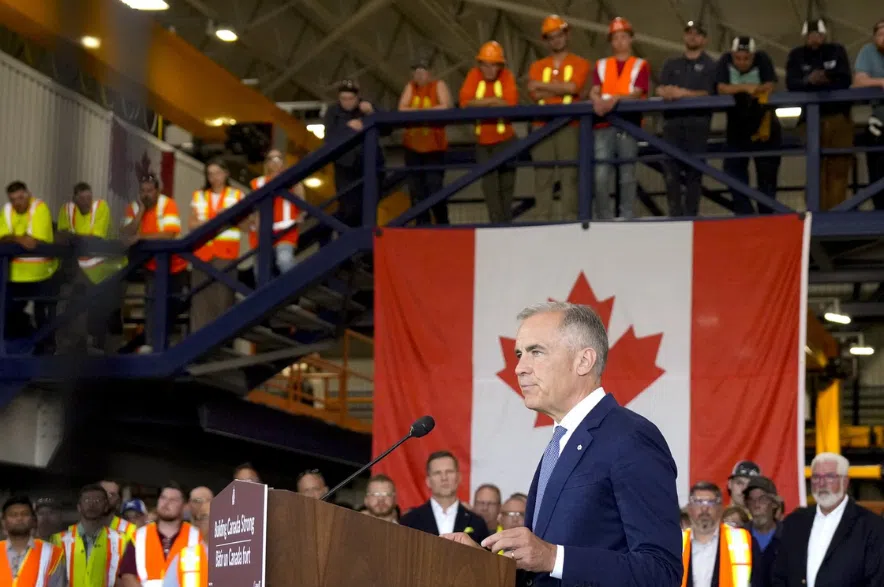Prime Minister Mark Carney announced Wednesday that the government was tightening rules around steel imports. The move is an effort to protect Canada’s domestic industry from dumping as the global trade of the metal undergoes major shifts because of government actions out of the United States and China.
Here’s a look at some of the key questions.
What is dumping?
Dumping refers to foreign firms selling goods at artificially low prices, or prices that don’t accurately reflect their cost of production. It can also mean a company selling goods for less in foreign markets than comparable goods are selling for in their home market.
Companies tend to dump goods either by selling below cost to gain market share, or because an excess of production in their home countries has them looking for markets to offload the goods and recover some costs.
Government subsidies can be a significant contributor to firms selling at artificial prices because they distort price structures. Subsidies can include simply giving money to companies to help them grow, more indirect aids like preferential access to land, as well as government loans and loan guarantees and tax breaks.
The Canadian government uses all of these levers to help grow domestic industries, but governments can only go so far within international trade rules. Subsidies that artificially reduce costs so manufacturers can flood foreign markets at unfairly low prices crosses that line.
Read more:
- Canada targets Chinese steel with higher tariffs
- Trump’s tariff threat to have ‘minimal’ impact: Sask. Premier
- Steelworkers applaud Ottawa’s move to safeguard local jobs
How big of a problem is steel dumping for Canada?
While dumping cases are determined on specific products, the overall scale of steel imports has swelled over the past decade. Offshore imports have climbed from 19 per cent of the Canadian market in 2014 to 39 per cent in 2022, according to the Canadian Steel Producers Association.
The steel industry also dominates anti-dumping inquiries at the Canadian International Trade Tribunal, the body tasked with determining whether imported goods are being sold at artificially low prices.
The Canadian steel industry has challenged dozens of product categories from cold- to hot-rolled steel, various wires, piping and rods, even including stainless steel sinks. The tribunal has largely ruled in favour of applications that dumping has occurred and is harming Canadian industry.
And while there are problems now, the bigger concern is how much more product, especially from China, might get diverted to the Canadian market as the U.S. moves to close off imports.
It’s also expected to be a growing problem in the future as China’s domestic demand slows. China already has 50 million tonnes of overcapacity in steel production across its 360 mills, according to Wood Mackenzie, but it said that overcapacity could swell to 250 million tonnes over the next decade. Canada’s total production, meanwhile, was 12.1 million tonnes in 2023.
How long has it been a problem?
A long time. Canada introduced the first anti-dumping provisions in the world in 1904, which singled out a “special duty on under-valued goods,” according to international trade expert Dan Ciuriak in a report.
What was unique about the measure was that it was a flexible tariff, meant to make up the difference between the selling price and the fair market value.
The problem has continued and grown as global trade has increased, leading to growing calls to do more about it.
For steel, concerns grew as China’s exports surged to 110 million tonnes in 2015 before starting to retreat, only for it to surpass that total in 2024 with 115 million tonnes in exports, according to the International Trade Administration.
Back in 2020, United Steelworkers union national director for Canada Ken Neumann said the problem of illegal steel dumping needs to stop.
“Our union will continue to aggressively defend the jobs of steelworkers across Canada who for too long have been harmed by steel imports dumped into our country and sold at unprofitable, below-market prices.”
What do the latest tariffs aim to achieve?
Canada already imposed 25 per cent tariffs on imports of steel and aluminum from China last year, with the move coming into place in October.
But the steel industry and others have maintained that other countries are taking steel produced in China, processing it further and then trying to export it as originating from the there.
The latest measures are meant to help protect against that work-around. That’s why the government imposed the 25 per cent tariff on steel products that were “melted and poured” in China.
The move is the culmination of years of efforts to increase transparency in steel imports, including a requirement that went into effect only last November for importers to declare the country the metal is melted and poured.
Catherine Cobden, CEO of the Canadian Steel Producers Association, said the measures will go some ways to tackle China’s actions as an “egregious” overcapacity practitioner.
“Canada is taking direct aim at global steel overcapacities, and frankly, it’s a strong position, and I think will be applauded around the world. This is something that even the United States hasn’t yet done.”
This report by The Canadian Press was first published July 18, 2025.
Ian Bickis, The Canadian Press











